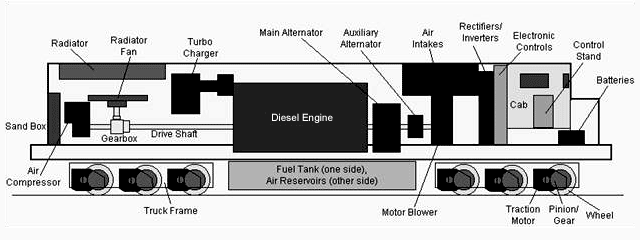|
A diesel-electric locomotive schematic - Date unknown Anonymous Artist.
11 October 2014
Nobody Can Argue With a Train Whistle
Saskatoon Saskatchewan - You probably have seen those railway pickup trucks with conventional wheels for the road and also a set of
steel wheels that can be lowered to run on railway tracks.
I always am a little envious when I see these things.
This is the way to travel.
Instead of battling idiot traffic, instead of laboriously steering the vehicle and paying attention to where you are going, you could relax and gaze at the
scenery as you whizzed along the smooth, steel rails.
Of course, you would have to schedule your journey so as not to meet a train coming the other way, with no chance of swerving.
That would be more like the opposite of relaxing.
"Reverse! Reverse!"
The concept of a vehicle that runs on both road and rail has yet to be fully exploited.
We have road vehicles that run on rails, but, as far as I can determine, no one has yet rigged a railway locomotive to also run on the road.
This would be the ultimate vehicle.
Humvees, SUVs, jacked-up pickups... all would make way for a railway locomotive coming through traffic.
In terms of size and power, the locomotive rules.
A typical example of the kind you might see pulling a train through Saskatoon is propelled by a 12-cylinder diesel engine generating 4,000
horsepower.
When you bring 4,000 horsepower to the table, you will see a lot of other vehicles folding.
Even the drivers of hybrid vehicles would have to acknowledge the supremacy of the street locomotive.
That's because a locomotive also is a hybrid.
The diesel engine turns a generator which powers four electric engines that turn the wheels.
Because it's a hybrid, you could drive a locomotive on the street and still be all sanctimonious over the environment.
True, a railway locomotive gets terrible gas mileage, less than a mile per gallon, apparently.
When the Prius drivers mention this, you can just blow the locomotive's mighty air-horn.
"Yes, but my Prius gets..."
"BLAAAAP!"
"...fossil fuels..."
"BLAAAP!"
"...climate change..."
"BLAAAAAAP!"
Nobody can argue with the mighty air horn.
Incidentally, the traditional railway whistle code for a train crossing a road is four blasts, two long, one short, one long.
You will need to learn this if you're driving a railway locomotive in the city.
You also should know that three short blasts warn others that the train is backing up.
These things have terrible visibility to the rear.
Aside from size and power, the one big difference between a railway locomotive and a conventional street vehicle is weight.
A locomotive weights about as much as 100 Humvees.
This weight would provide unprecedented traction on snow and ice, at the expense of chewing up the pavement a little underneath.
There also is the little matter of steering.
Railway locomotives do not have a steering wheel.
They are designed to go where the tracks go.
Some models, however, do have what are called steerable trucks.
This means the wheel assemblies automatically pivot a little to accommodate curved track.
Significant modifications still would be required to make a locomotive steer like a car, but there is no practical reason beyond ordinary common sense and
total lack of financing why this could not be done.
A street locomotive also would be limited in terms of speed.
It probably could not go much over 100 kilometres per hour.
But high-speed performance really is wasted in city driving anyway.
In traffic on Circle Drive North, say, at 5 p.m., a locomotive would go exactly the same speed as a Bugatti Veyron: 10 km/h.
Getting in and out of a railway locomotive is another small problem.
The cab is higher than a rooftop bar.
If you're parking it in the city, the way to get out is to step onto the roof of an SUV and then jump down from there.
Les MacPherson.
|

